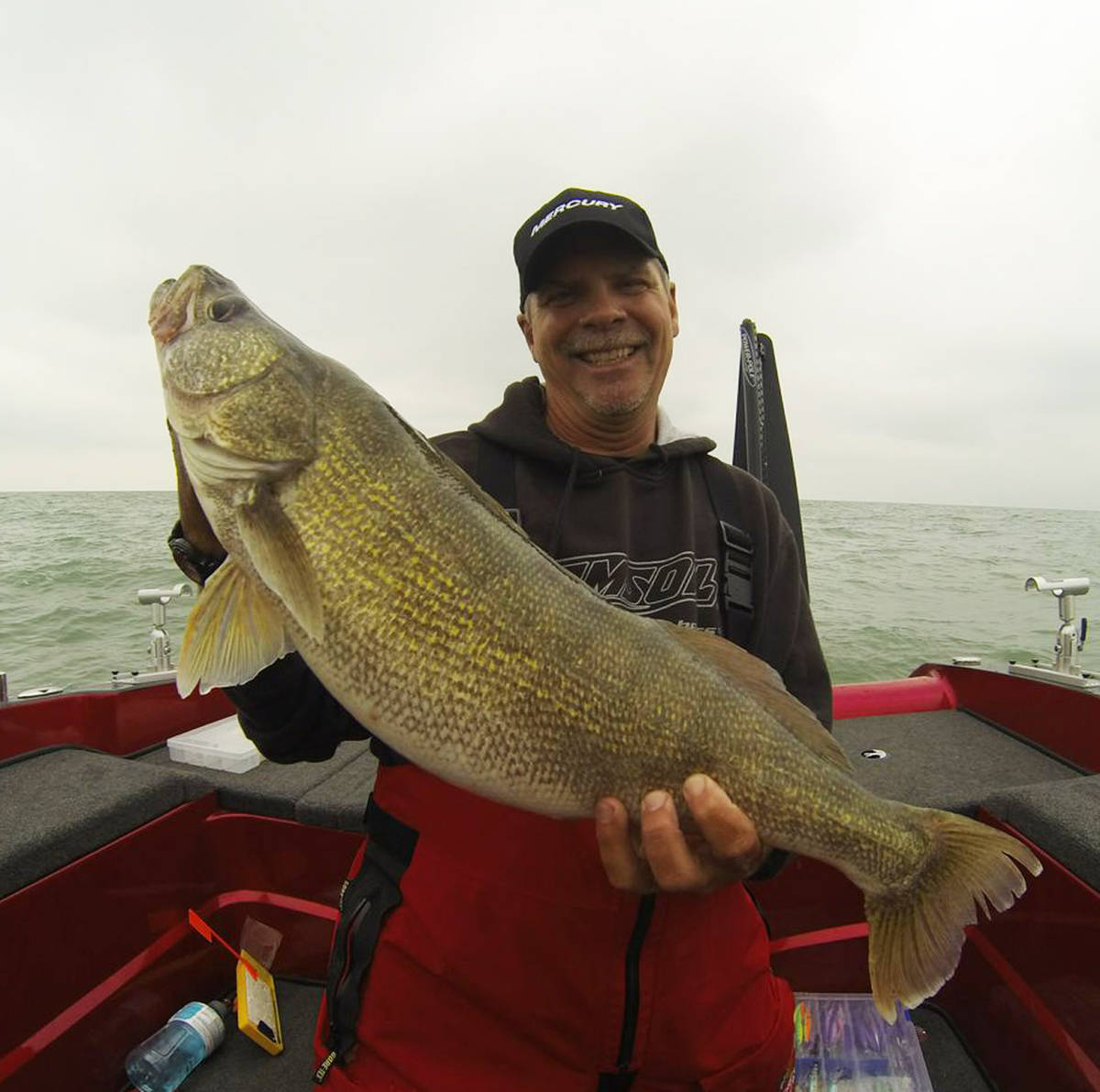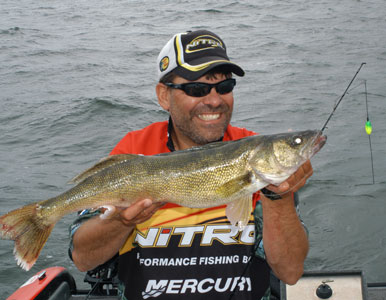 To most walleye anglers it’s a familiar story; you’ve waited all week for the chance to hook up the boat and hit the water for some well deserved fishin’ time. The weather forecast is for partly cloudy skies, moderate temps and winds ranging from 10 to 15 mph. But when you get to the lake, the winds are more like 20 to 30 mph and there’s a serious “walleye chop”. Late summer walleye fishing can be a challenge on calm days, but add the factor of wind, and the task can become more like work than recreation … that is unless you’re ready for it. With the right equipment, the know-how to use it, and a basic understanding of how wind can effect walleye location and behavior, you can put together a game plan for fishing walleyes in this kind of “summer breeze” and be more productive than if you’d been dealt a calm day to fish.
To most walleye anglers it’s a familiar story; you’ve waited all week for the chance to hook up the boat and hit the water for some well deserved fishin’ time. The weather forecast is for partly cloudy skies, moderate temps and winds ranging from 10 to 15 mph. But when you get to the lake, the winds are more like 20 to 30 mph and there’s a serious “walleye chop”. Late summer walleye fishing can be a challenge on calm days, but add the factor of wind, and the task can become more like work than recreation … that is unless you’re ready for it. With the right equipment, the know-how to use it, and a basic understanding of how wind can effect walleye location and behavior, you can put together a game plan for fishing walleyes in this kind of “summer breeze” and be more productive than if you’d been dealt a calm day to fish.
The first rule of fishing in windy conditions is safety. Don’t be caught on rough water in a boat not suited for the conditions. You need a boat capable of getting to the fish and back in one piece. Longer is better. Longer boat length allows the spanning of waves, making for a softer ride. A bigger boat will typically be wider, which helps give a dryer ride. Longer boats also allow the use of more powerful outboard motors. For a walleye boat, the “muscle” motor is not necessarily for speed, (although flying along at 60+ MPH on a calm summer day is a lot of fun) but more for the responsiveness needed to run rough water.
There are a few secrets to successfully running in rough water. Most importantly ride the waves, don’t man-handle them. When you see a trough or flat area in the waves, you can accelerate through. When you see the big waves coming (and it seems like they always come in threes) then back off. The Nitro ZV21’s that we now run are equipped with 300 hp Mercury Verado engines. This engine delivers the responsiveness needed to handle big waves, including most of those encountered on the Great Lakes and other large bodies of water.
Once you get to the fishing spot, boat control becomes the primary challenge in windy conditions. The fish’s location will have a lot to do with what presentation you’re going to use, and that will dictate your boat control options. For instance, let’s say the walleyes are set up along the secondary break or in the “cups” on points. This is a good situation for using bottom bouncer rigs. The bottom bouncer rig tipped with a leech or lively minnow lets you work right in the fish’s face. In windy conditions remember, you’ll probably need to use a slightly heavier bouncer that normal, opting for a 2 ounce bouncer over a 1 ounce for instance, to maintain bottom contact.
For this tactic, the right bowmount trolling motor will allow the presentation of bait in the best fashion. You’ll want a powerful, long shafted motor. The 36 volt MotorGuide Xi5 Wireless Trolling Motor we run features a 60 inch shaft and 105 pounds of thrust so there’s no problem staying over fish against strong winds and pounding waves. If your boat is a bit smaller, say in the 17 to 18 ft. range, a 24 volt, 80 pound thrust MotorGuide Xi5 with the 54 inch shaft may be a better choice.
On lakes where it’s legal to use two rods, this is a perfect time to use the waves to your advantage. Try fishing with one rod in your hand and another one, what we refer to  as a “Dead Stick”, in a rod holder within easy reach. A Dead Stick should be long, 10 to 12 ft., with a strong backbone yet softer tip section. Our Bass Pro Shops Walleye Angler Signature Series rods, models WA10T-2 and WA12T-2, are excellent rods for this technique. Rigged with a bottom bouncer, plain snell, and live bait, the waves will impart a “lift and drop” action to the rod that inevitably triggers fish that will ignore the “hand-held” rod. This may well be one time when it would pay to set up two Dead Rods, then just sit back, kick up your feet, and wait for the action to begin.
as a “Dead Stick”, in a rod holder within easy reach. A Dead Stick should be long, 10 to 12 ft., with a strong backbone yet softer tip section. Our Bass Pro Shops Walleye Angler Signature Series rods, models WA10T-2 and WA12T-2, are excellent rods for this technique. Rigged with a bottom bouncer, plain snell, and live bait, the waves will impart a “lift and drop” action to the rod that inevitably triggers fish that will ignore the “hand-held” rod. This may well be one time when it would pay to set up two Dead Rods, then just sit back, kick up your feet, and wait for the action to begin.
Trolling open water with spinners tipped with crawlers or crankbaits can also be very effective on some wind-swept bodies of water, especially on the Great Lakes and some larger inland waters. Here you can rely on a kicker motor for boat control like Mercury’s 9.9 hp Pro-Kicker. Trolling with the waves will make this task must easier, allowing you to maintain a more consistent trolling speed. In real blustery winds, you may even want to shift the kicker in and out of gear to get the right speed. The wind and waves camouflage the sound of the motor overhead, so even trolling in shallow water is not a problem.
Another option may even be to use your big outboard. With Mercury’s SmartCraft technology you can actually control the RPMs of the big engine right from your dash using the SC1000 Tach/Speedometer System and its Troll Control™ mode, adjusting it down to the point that you can reach very effective trolling speeds even with a 300 hp outboard. The beauty of this is that in really big waves, you’ll have the extra power to adjust your course at the touch of the throttle, should a big gust blow you off line.
Of course, those are not the only tactics that will produce under windy conditions. Every lake or river will have its own best presentation on a given day. It may be pitching jigs to wind-beaten shorelines, or slip-bobbering main-lake reefs. The key is to understand how the wind will affect the walleye’s location and how to best maintain your boat control for optimum safety and effectiveness.
Fishing for walleyes in a “Summer Breeze” (of 15+ mph) can be a frustrating venture, but with the right equipment and techniques you can put together a game plan that might just turn out to be the hottest bite you’ll have this season.










